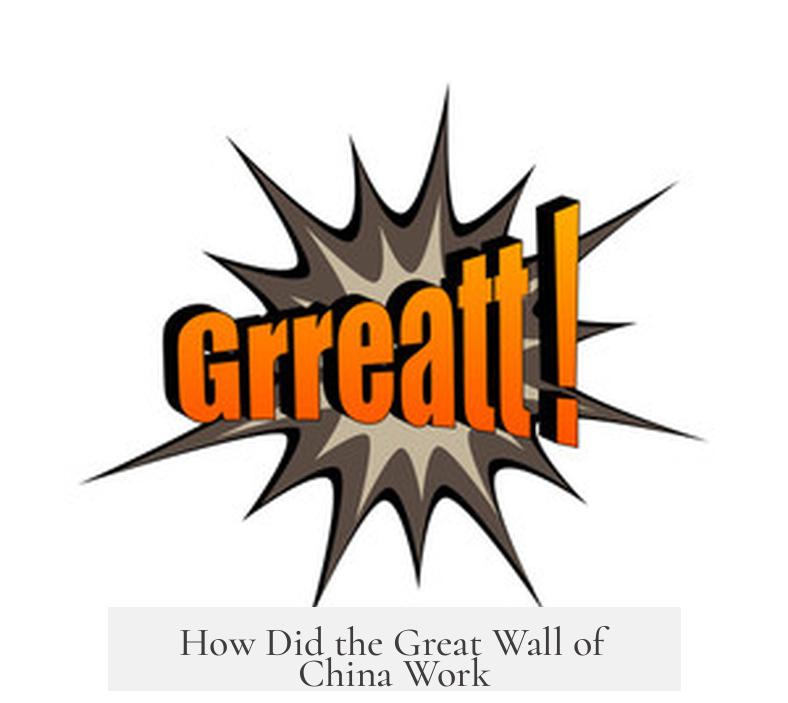The Great Wall of China worked as a sophisticated defense system combining physical barriers, signal communication, military strategy, and diplomacy to protect Chinese territories from northern nomadic invasions.
The wall was not a singular continuous structure guarded uniformly by troops along its whole length. Instead, key segments and fortifications played major defensive roles. The defense concentrated in select locations such as major army garrisons positioned along the wall or nearby, gate towns containing garrison forces, and special gate forts. These spots served as hubs from which forces could rapidly respond to threats.
Beacon towers were critical components enabling communication across vast distances. These towers, placed roughly one mile apart, sent smoke signals by day and fires by night. A system of coded signals conveyed the scale and location of approaching enemies. For example, one fire indicated fewer than 1,000 attackers, two fires meant over 1,000, and three fires showed that the tower itself was under attack. The signal would then be relayed along the wall rapidly, allowing nearby troops to mobilize efficiently.
Instead of staffing the entire wall heavily, the Chinese relied on mobile garrison armies near or along the wall. These forces could deploy quickly to any threatened section, balancing limited manpower with wide coverage. This “rapid-response” strategy allowed the wall to function effectively without unrealistic manpower demands.
Besides active defense, Chinese dynasties often launched offensive campaigns into the northern steppes. These invasions aimed to subjugate or diminish the power of nomadic tribes before they could launch raids. The Great Wall was one element of a larger military approach that combined fortifications with proactive attacks.
Diplomatically, the Chinese maintained relations with tribes just beyond the wall. The government sought to pacify or ally with some tribes to create a buffer zone, reducing conflict frequency. At times, different nomadic groups were manipulated to prevent them uniting into a large invading force. Hence, the wall and diplomacy were intertwined defense tools.
| Aspect | Function |
|---|---|
| Beacon Towers | Communicate enemy approach using smoke and fire signals |
| Key Garrison Spots | Concentrate troops for quick response |
| Mobile Armies | Deploy quickly to threatened sections |
| Offensive Campaigns | Preemptively attack nomadic tribes |
| Diplomatic Relations | Maintain peace through alliances and buffer tribes |
The wall’s construction spanned centuries and dynasties. It did not start as a single continuous structure. Initially, independent Chinese states built separate walls during the Zhou dynasty to defend themselves and control territory. After China’s unification by the Qin dynasty, many northern walls were connected to form a more extensive system.
Construction methods evolved over time. Early walls used compacted earth built by corvee labor. Builders took advantage of natural obstacles such as mountains and impassable terrain to reduce workload. The most recognizable stone and brick sections belong to the Ming dynasty, which rebuilt large parts of the wall with durable materials.
It is important to note the Great Wall was not always the boundary of Chinese-controlled land. At times, dynasties controlled extensive territory beyond it. The wall acted as a fortified border where threats were most likely. It deterred raids and invasions from groups such as the Huns and later the Mongols.
The wall proved effective in slowing nomadic incursions. The Huns, known for devastating Rome centuries earlier, were kept at bay during early periods. Major nomadic invasions typically happened when China was internally divided, an example being the collapse of the Song dynasty when the Jurchen and later Mongols took control of northern China.
China also employed a tribute system, paying nomadic tribes to avoid conflict. This system complemented the wall by adding economic incentives to peace, showing the multifaceted strategic approach involving military, fortification, diplomacy, and politics.
- The Great Wall combined physical defense with signal towers and mobile troops for efficient protection.
- It was built over many centuries by multiple dynasties, evolving in materials and structure.
- Offensive military campaigns and diplomacy were integral to its overall strategy.
- Signal fires transmitted alerts quickly, enabling rapid responses to threats.
- The wall’s purpose was deterrence and defense against nomadic raids and invasions.
How Did the Great Wall of China Work?

The Great Wall of China worked as a complex defense mechanism, combining physical barriers, military strategy, communication systems, and diplomacy to protect China from invasions and maintain territorial control. It’s more than just a big stone fence—it’s a centuries-old military masterpiece designed to deter, detect, and defeat nomadic threats.
So, how exactly did this giant structure keep enemies at bay? Let’s break it down.
The Defense Strategy: More Than Just a Wall
First, the wall wasn’t guarded evenly. Instead, it focused on key defensive spots. Think of these as the “choke points” in modern warfare:
- Major army garrisons near the wall.
- Gate garrison towns where the main access points were.
- Gate forts functioning as mini-fortresses.
This setup meant defenders could allocate resources efficiently, keeping huge armies at gatehouses ready to repel attacks.
Have you ever wondered how messages raced along the wall without Twitter? Beacon towers were the answer. These towers lit smoke signals by day and fires by night. They sent urgent alerts along the wall to mobilize nearby troops. For example:
- One fire? Less than 1,000 attackers approach.
- Two fires? A big force of more than 1,000 arrives.
- Three fires? The tower is under attack!
This signaling system was so effective that messages could travel incredibly fast across vast distances. Imagine a line of bonfires spreading urgency like wildfire—literally!
Instead of trying to guard the entire wall continuously (which would have been impossible), China used rapid-response garrison armies. These forces were stationed near important wall sections and could move quickly to hotspots. This flexibility turned the Great Wall from a static barrier into a dynamic defense line.
Interestingly, China didn’t just build walls and wait. Throughout history, they launched offensive military campaigns to subjugate nomadic tribes. Taking the fight northward meant dealing with threats before they reached the wall.
Diplomacy: The Wall’s Silent Partner
The Great Wall wasn’t just about brute force; it was part of a larger diplomatic strategy. The Chinese government maintained relations with tribes just outside the wall, using:
- Tributary systems—paying off nomads to stay peaceful.
- Buffer tribes to absorb attacks from further away.
- Divide-and-conquer tactics—manipulating tribes to avoid united invasions.
Diplomacy kept many dangerous coalitions at bay and made the wall more effective than just bricks and mortar.
Construction and Evolution: A Wall Over Time

Did you think the Great Wall was built all at once? Think again! The wall we know today is actually the result of thousands of years of piecemeal construction. It started back as early as the Zhou dynasty as independent walls built by different Chinese states.
After Qin Shi Huang unified China around 221 BCE, these walls were linked together, creating one large network. This shows how the wall evolved alongside China’s political changes.
Also, the wall wasn’t always made from the sturdy bricks you see today. Early walls were compacted earth, supported by natural barriers like mountains to save labor and time. Labor for this grueling work was mostly conscripted (forced) from the population.
Later, during the Ming Dynasty, the wall was rebuilt in bricks, giving it that iconic look. So, the wall was a living project, maintained and improved depending on the dynasty’s resources and enemy threats.
Purpose and Effectiveness: Did It Really Work?
The Great Wall’s main goal was deterring raiders from the northern steppes. It wasn’t just stopping any invader; originally, it aimed to keep powerful groups like the Huns out, who, as history tells us, could wreak havoc (just recall their mess in Roman territories—yikes!).
Despite its strength, major invasions still happened during times of internal chaos in China:
- The 4th century’s “Five Barbarians” period.
- The 12th century when the Jurchen took northern China.
- Even when Genghis Khan invaded, the wall wasn’t entirely effective.
Yet, that doesn’t mean the wall failed. It functioned as a major deterrent and slowed invaders, buying time to organize defenses. Plus, China’s tribute system helped—nomadic tribes were often bribed to stay peaceful, reducing direct attacks.
One impressive feature was the watch tower signal system. Watch towers were placed roughly every mile. When a tower spotted an enemy, it lit fires that neighboring towers would see and light in turn, passing the message swiftly along the wall. This alert mechanism gave defenders precious seconds or minutes to prepare for incoming attacks.
What Can We Learn From the Great Wall?
The Great Wall teaches us that defense isn’t just about walls but also about strategy, communication, and community management. It was less about creating an impenetrable barrier and more about managing risks with limited resources.
If you’re managing a project, a team, or even household chaos, consider how you can:
- Identify your “key points”—where attention matters most.
- Set up rapid alerts using simple systems.
- Build flexible response teams instead of trying to cover everything at once.
- Keep good relations with neighbors and stakeholders.
Maybe you won’t need a massive wall, but you can definitely build a great strategy!
Final Thoughts
The Great Wall of China worked as a multifunctional defense network. It combined physical barriers, rapid military deployment, sophisticated signaling, and diplomatic efforts. It adapted over centuries, reflecting China’s evolving political landscape and military needs.
So next time you think about that winding stone giant snaking over the hills, remember—it wasn’t just a wall, it was China’s ancient high-tech security system.
Would you have handled the beacon tower signals better? Or maybe led a rapid-response army yourself? The Great Wall of China sure invites us to imagine the ingenuity behind one of history’s greatest defensive works.




